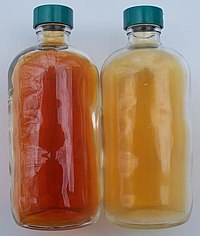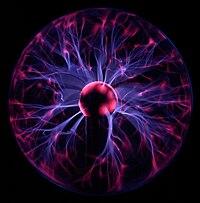Matter (physics)
   
|
|
| Matter is usually classified into three classical states, with plasma sometimes added as a fourth state. From top to bottom: quartz (solid), water (liquid), nitrogen dioxide (gas), and a plasma globe (plasma). |
In the classical physics observed in everyday life, matter is any substance that has mass and takes up space; this includes atoms and anything made up of these, but not other energy phenomena or waves such as light or sound. More generally, however, in (modern) physics, matter is not a fundamental concept because a universal definition of it is elusive; for example, the elementary constituents of atoms may be point particles, each having no volume individually.
All the everyday objects that we can bump into, touch or squeeze are ultimately composed of atoms. This ordinary atomic matter is in turn made up of interacting subatomic particles—usually a nucleus of protons and neutrons, and a cloud of orbiting electrons. Typically, science considers these composite particles matter because they have both rest mass and volume. By contrast, massless particles, such as photons, are not considered matter, because they have neither rest mass nor volume. However, not all particles with rest mass have a classical volume, since fundamental particles such as quarks and leptons (sometimes equated with matter) are considered "point particles" with no effective size or volume. Nevertheless, quarks and leptons together make up "ordinary matter", and their interactions contribute to the effective volume of the composite particles that make up ordinary matter.
Matter exists in states (or phases): the classical solid, liquid, and gas; as well as the more exotic plasma, Bose–Einstein condensates, fermionic condensates, and quark–gluon plasma.
...
Wikipedia
